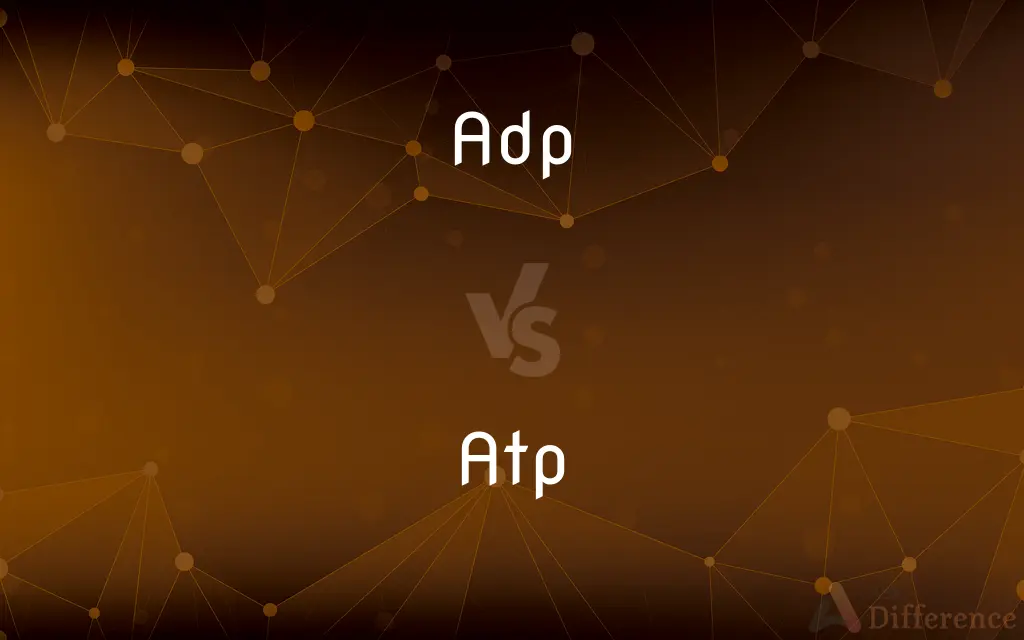ADP vs. ATP — What's the Difference?
By Tayyaba Rehman — Updated on September 23, 2023
ADP (Adenosine Diphosphate) is a molecule involved in energy transfer within cells and has two phosphate groups. ATP (Adenosine Triphosphate) is its more energy-rich counterpart with three phosphate groups, often called the "energy currency" of cells.

Difference Between ADP and ATP
Table of Contents
ADVERTISEMENT
Key Differences
ADP, or Adenosine Diphosphate, is a molecule that plays a crucial role in energy metabolism in cells. It consists of adenosine and two phosphate groups. On the other hand, ATP, or Adenosine Triphosphate, also plays a vital role in cellular activities but contains three phosphate groups. ATP is considered more energy-rich than ADP.
Both ADP and ATP function as energy carriers in cellular activities, but their roles differ slightly. When a cell needs to perform work, ATP provides the energy by losing one of its phosphate groups, turning into ADP. Once ATP is converted to ADP, the latter can be converted back to ATP through a process called phosphorylation.
In the grand scheme of cellular respiration and energy transfer, ADP and ATP work in a cycle. ATP releases energy when it gives up a phosphate and becomes ADP. In contrast, ADP needs to gain a phosphate group to become ATP again, storing energy in the process. This cycle is critical for many cellular functions, from muscle contraction to the transmission of nerve signals.
ADP is not as energy-dense as ATP, but it is crucial for energy storage and transfer. Without ADP, the cycle of energy release and storage that involves ATP would not be possible. Both molecules are essential for life as they are fundamental for powering cellular processes.
Comparison Chart
Phosphate Groups
Two phosphate groups
Three phosphate groups
ADVERTISEMENT
Energy Content
Lower
Higher
Conversion
Turns into ATP
Turns into ADP
Role
Energy storage and transfer
Energy release and transfer
Involvement in Cycle
Gains a phosphate group
Loses a phosphate group
Compare with Definitions
Adp
ADP is an energy-transfer molecule with two phosphate groups.
ADP gains a phosphate group to convert into ATP.
Atp
ATP is known as the "energy currency" of the cell.
ATP provides the energy needed for cellular processes.
Adp
ADP serves as an intermediate form of energy storage.
ADP stores energy until it can be converted back to ATP.
Atp
ATP contains three phosphate groups.
The extra phosphate group in ATP stores more energy than ADP.
Adp
ADP can be phosphorylated to become ATP.
The phosphorylation of ADP is essential in cellular respiration.
Atp
ATP powers various cellular functions.
ATP is fundamental for processes like muscle contraction.
Adp
ADP is derived from ATP.
When ATP loses a phosphate group, it becomes ADP.
Atp
ATP releases energy when converted to ADP.
When ATP turns into ADP, energy is released to do work.
Adp
ADP is involved in cellular metabolism.
ADP plays a vital role in the energy cycles of the cell.
Atp
ATP is produced from ADP through phosphorylation.
The conversion of ADP to ATP occurs in the mitochondria.
Adp
A nucleotide, C10H15N5O10P2, that is composed of adenosine and two linked phosphate groups, and that is converted to ATP for the storage of energy in living cells.
Atp
A nucleotide, C10H16N5O13P3, that is composed of adenosine and three phosphate groups and releases energy when hydrolyzed to ADP. It is present in all cells, where it is used to store and transport energy needed for biochemical reactions.
Adp
An ester of adenosine that is converted to ATP for energy storage
Atp
A nucleotide derived from adenosine that occurs in muscle tissue; the major source of energy for cellular reactions
Adp
Data processing by a computer
Common Curiosities
How many phosphate groups does ATP have?
ATP has three phosphate groups.
Where are ADP and ATP found?
Both are found in the cells of living organisms.
Which molecule is more energy-rich, ADP or ATP?
ATP is more energy-rich than ADP.
What does ATP stand for?
ATP stands for Adenosine Triphosphate.
How many phosphate groups does ADP have?
ADP has two phosphate groups.
What happens to ATP when energy is needed?
ATP loses a phosphate group and converts into ADP, releasing energy.
What role does ADP play in the cell?
ADP serves as an energy storage and transfer molecule.
Can ATP exist without ADP?
No, the conversion between ATP and ADP is a continuous cycle in cells.
What is the process that turns ATP into ADP called?
The process is known as hydrolysis.
What does ADP stand for?
ADP stands for Adenosine Diphosphate.
How is ADP converted to ATP?
ADP is converted to ATP through a process called phosphorylation.
Do both ADP and ATP participate in cellular respiration?
Yes, both are crucial in the cellular respiration process.
Is ADP less important than ATP?
Both are equally important; ADP stores and transfers energy, while ATP releases it.
What role does ATP play in the cell?
ATP serves as the primary energy currency for cellular processes.
What is the significance of the third phosphate group in ATP?
The third phosphate group in ATP stores the extra energy.
Share Your Discovery

Previous Comparison
Freeway vs. Motorway
Next Comparison
Immigrant vs. NonimmigrantAuthor Spotlight
Written by
Tayyaba RehmanTayyaba Rehman is a distinguished writer, currently serving as a primary contributor to askdifference.com. As a researcher in semantics and etymology, Tayyaba's passion for the complexity of languages and their distinctions has found a perfect home on the platform. Tayyaba delves into the intricacies of language, distinguishing between commonly confused words and phrases, thereby providing clarity for readers worldwide.














































